The Variable Moving Average (VMA) dynamically adjusts its own smoothing period to the changing market conditions based on a Volatility Index (VI). While any VI can be used, in this article we will look at how the VMA performs using the Fractal Dimension (D). This measure was originally used by John F Ehlers as a component in his Fractal Adaptive Moving Average (FRAMA) which has so far set the standard in our moving average tests.
We did have to make one slight modification to the Fractal Dimension however. The Volatility index in a VMA needs to shift through a 0 – 1 range where higher readings indicate a stronger trend. The Fractal Dimension shifts through a 1 – 2 range where lower readings indicate a stronger trend. Therefore we shall use = ABS(D – 2).
The D-VMA requires two user selected inputs: A Fractal Dimension Period and a VMA period. We tested trades going Long and Short, using Daily data, taking End Of Day (EOD) and End Of Week (EOW) signals~ analyzing all combinations of:
D = 10, 20, 40, 80, 126, 252
VMA = 5, 10, 15, 20, 25, 30, 35, 40, 45, 50
The D lengths were selected due to the fact that they correspond with the approximate number of trading days in standard calendar periods: 10 days = 2 weeks, 20 days = 1 month, 40 days = 2 months, 80 days = ⅓ year, 126 days = ½ year and there are 252 trading days in an average year.
The VMA periods were selected after preliminary tests showed that when combined with the different ER lengths they resulted in median smoothing periods between 12 and 133 days; a range that should capture the best results based on what we know from previous research into moving averages.
A total of 240 different averages were tested and each one was run through 300 years of data across 16 different global indexes (details here).
Download A FREE Spreadsheet With Raw Data For
All 240 D-VMA Long and Short Test Results
.
D Variable Moving Average EOD vs EOW Returns:
.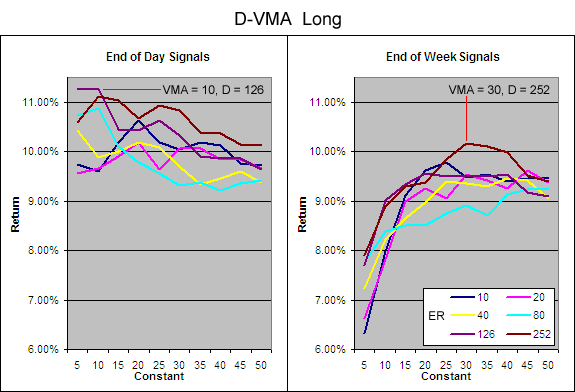
.
It must be noted that every single D-VMA using EOD or EOW signals managed to outperform the average buy and hold annualized return of 6.32%^ during the test period (before allowing for transaction costs and slippage). This is very impressive when you consider that most fund managers fail to out perform a simple buy and hold approach.
Clearly the D periods of 126 and 252 produced the best results using both EOD and EOW signals. This echoes previous results on other ‘intelligent’ moving averages. The 126 Day D-VMA with a constant of 10 stands out as the best performer with EOD signals while the 252 Day D-VMA with a constant of 30 was the best when taking EOW signals.
Because the returns hold up so well when using EOW signals lets take a closer look at the how the probability of profit and trade duration compares for EOD and EOW signals with a D of 126 and 252:
.
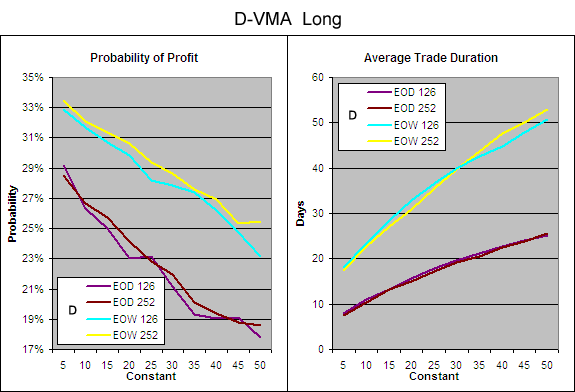 .
.
Clearly there is a large jump in the probability of profit and the average trade duration when using EOW signals; both are highly desirable characteristics especially if they can be achieved without sacrificing too much return.
.
Best EOD Efficiency Ratio Variable Moving Average
.
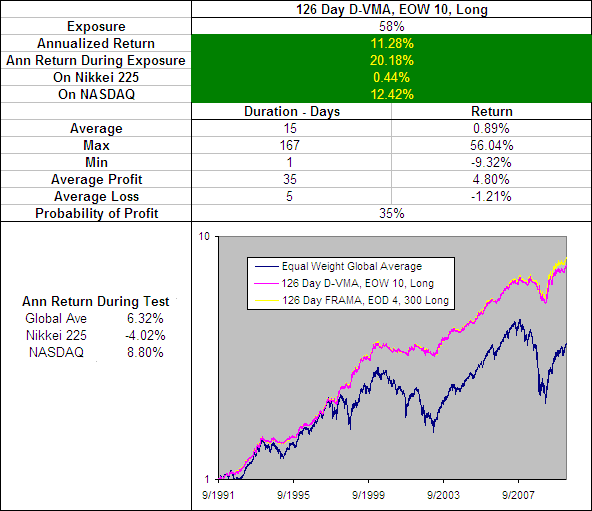 .
.
I have included on the above chart the performance of the 126 Day FRAMA, EOD 4, 300 Long becuase so far this has been the best performing Moving Average. The 126 Day D-VMA, EOD 10, Long produced almost identical results to the best that the FRAMA could produce and there is really very little between the two.
.
126 Day D-VMA, EOD 10 – Smoothing Period Distribution
.
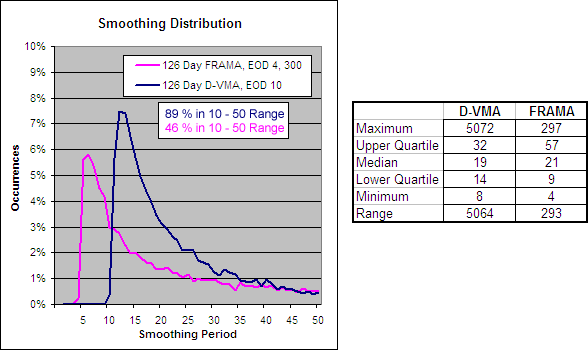 .
.
The smoothing distribution for the two averages has a similar shape but the D-VMA starts from 10 and the FRAMA starts from 4.
.
126 Day D-VMA, 1 – Alpha Comparison
.
To get an idea of the readings that created these results we charted a section of the alpha for the 126 Day D-VMA, 1 and compared it to the best performing FRAMA to see if there were any similarities that would reveal what makes a good volatility index:
.
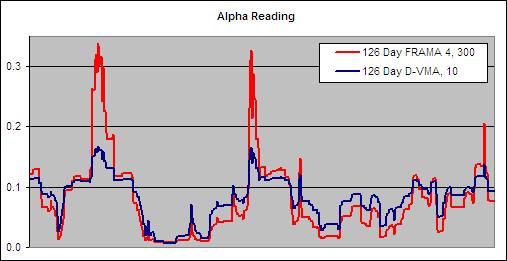 .
.
It is not surprising that the shapes of the alpha readings are almost identical because they are both based on the same Fractal Dimension reading. The only real difference is that the FRAMA tends to move to extremes more readily.
.
Best EOW Efficiency Ratio Variable Moving Average
.
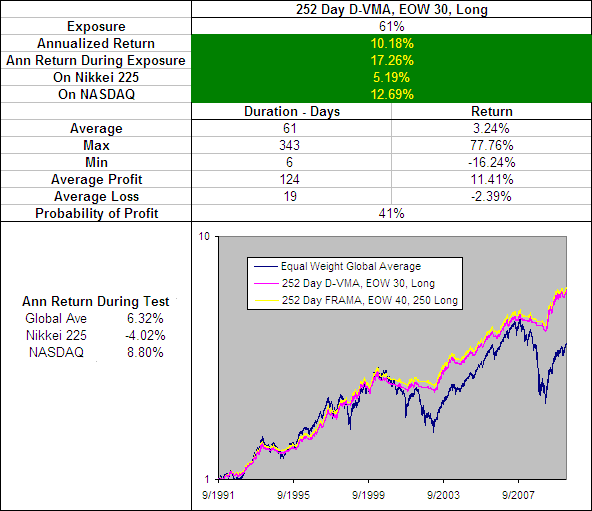 .
.
I have included on the above chart the performance of the 252 Day FRAMA, EOW 40, 250 Long becuase so far this has been the best performing ‘slower’ Moving Average. The 252 Day D-VMA, EOW 30, produced almost the exact same results but did under perform ever so slightly.
.
252 Day D-VMA, EOW 30 – Smoothing Period Distribution
.
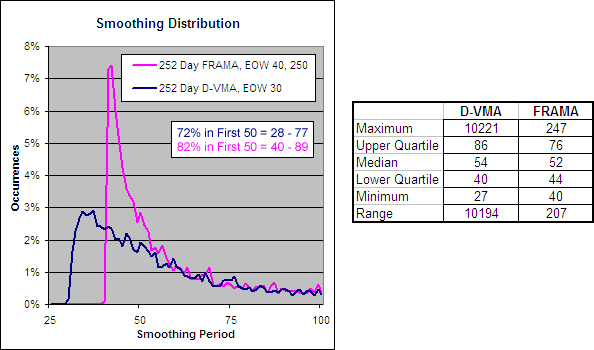 .
.
The smoothing distribution for the 252 Day D-VMA, 30 is more spread than that of the FRAMA but is still very similar.
.
252 Day D-VMA, 30 – Alpha Comparison
.
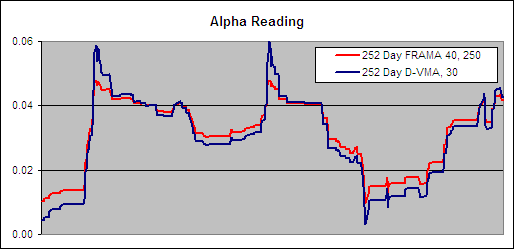 .
.
Not surprisingly you can see the close similarity between the alpha readings for the D-VMA and the FRAMA thus the similar performance.
.
Conclusion
.
The fact that the D-VMA produces almost the exact same results to the FRAMA shows that the volatility index is more important than the method for translating those readings into an ‘intelligent’ moving average. However because the FRAMA offers more control and fractionally better returns it remains the best moving average we have found so far.
Want to use the Fractal Dimension Variable Moving Average? Get a free Excel spreadsheet at the flowing link under Downloads – Technical Indicators: Variable Moving Average (VMA). It will automatically adjust to one of many different VIs that you can select including the Fractal Dimension used in this article.
.
For more in this series see – Technical Indicator Fight for Supremacy
.
- ~ An entry signal to go long (or exit signal to cover a short) for each average tested was generated with a close above that average and an exit signal (or entry signal to go short) was generated on each close below that moving average. No interest was earned while in cash and no allowance has been made for transaction costs or slippage. Trades were tested using End Of Day (EOD) and End Of Week (EOW) signals on Daily data. Eg. Daily data with an EOW signal would require the Week to finish above a Daily Moving Average to open a long or close a short while Daily data with EOD signals would require the Daily price to close above a Daily Moving Average to open a long or close a short and vice versa.
- ^ This was the average annualized return of the 16 markets during the testing period. The data used for these tests is included in the results spreadsheet and more details about our methodology can be found here.
Hi Derry, You lost me with all this math! You must be a math major (or professor!), but most people aren’t . Question I have, is the 126 day average for a calendar day or a Wall Street day? I do understand EOD and EOW, ha. If you could simplify this more it would help. We appreciate all the work you have done, however FrancesQ
Haha, maths professor! Thanks for the complement FrancesQ! I will let you in on a secret… I failed calculus (it was boring and I am lazy).
With technical indicators the number or periods refers to the number of data points so in this case it will be number of Wall Street days or days that the market is open. Great question, thanks for clarifying that and I am glad that my number dorkery is of use to you.
Cheers
Derry